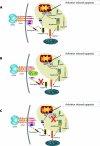T cell apoptosis and inflammatory bowel disease
- PMID: 15479669
- PMCID: PMC1774279
- DOI: 10.1136/gut.2004.040824
T cell apoptosis and inflammatory bowel disease
Figures

Comment on
-
Divergent cell cycle kinetics underlie the distinct functional capacity of mucosal T cells in Crohn's disease and ulcerative colitis.Gut. 2004 Nov;53(11):1624-31. doi: 10.1136/gut.2003.033613. Gut. 2004. PMID: 15479683 Free PMC article.
-
Induction of T lymphocyte apoptosis by sulphasalazine in patients with Crohn's disease.Gut. 2004 Nov;53(11):1632-8. doi: 10.1136/gut.2003.037911. Gut. 2004. PMID: 15479684 Free PMC article.
Similar articles
-
[Functional status of intestinal t lymphocytes, regulatory mechanisms, and their variations in the course of Crohn disease and ulcerative colitis].Ann Ist Super Sanita. 1999;35(2):283-9. Ann Ist Super Sanita. 1999. PMID: 10645662 Review. Italian.
-
Role of the innate immune system in the pathogenesis of inflammatory bowel disease.J Pediatr Gastroenterol Nutr. 2009 Feb;48(2):142-51. doi: 10.1097/MPG.0b013e3181821964. J Pediatr Gastroenterol Nutr. 2009. PMID: 19179875 Review.
-
[Chronic inflammatory bowel diseases: immunologic changes--cause or epiphenomenon?].Z Gastroenterol Verh. 1989 Jul;24:26-30. Z Gastroenterol Verh. 1989. PMID: 2474975 Review. German. No abstract available.
-
Differential regulation of interleukin 17 and interferon gamma production in inflammatory bowel disease.Gut. 2009 Dec;58(12):1629-36. doi: 10.1136/gut.2009.182170. Epub 2009 Sep 8. Gut. 2009. PMID: 19740775
-
The immunology of inflammatory bowel disease.Henry Ford Hosp Med J. 1982;30(1):25-32. Henry Ford Hosp Med J. 1982. PMID: 6123493 Review. No abstract available.
Cited by
-
Rac Attack: Modulation of the Small GTPase Rac in Inflammatory Bowel Disease and Thiopurine Therapy.Mol Diagn Ther. 2016 Dec;20(6):551-557. doi: 10.1007/s40291-016-0232-1. Mol Diagn Ther. 2016. PMID: 27604084 Free PMC article. Review.
-
Hematopoietic cell transplantation for Crohn's disease; is it time?World J Gastroenterol. 2006 Nov 7;12(41):6665-73. doi: 10.3748/wjg.v12.i41.6665. World J Gastroenterol. 2006. PMID: 17075981 Free PMC article. Review.
-
Apoptosis markers of circulating leukocytes are associated with the clinical course of inflammatory bowel disease.Gastroenterol Hepatol Bed Bench. 2018 Winter;11(Suppl 1):S53-S58. Gastroenterol Hepatol Bed Bench. 2018. PMID: 30774808 Free PMC article.
-
Moxibustion inhibits interleukin-12 and tumor necrosis factor alpha and modulates intestinal flora in rat with ulcerative colitis.World J Gastroenterol. 2012 Dec 14;18(46):6819-28. doi: 10.3748/wjg.v18.i46.6819. World J Gastroenterol. 2012. PMID: 23239920 Free PMC article.
-
Association between CTLA-4 gene promoter (49 A/G) in exon 1 polymorphisms and inflammatory bowel disease in the Tunisian population.Saudi J Gastroenterol. 2009 Jan;15(1):29-34. doi: 10.4103/1319-3767.43285. Saudi J Gastroenterol. 2009. PMID: 19568552 Free PMC article.
References
-
- Ina K , Itoh J, Fukushima K, et al. Resistance of Crohn’s disease T cells to multiple apoptotic signals is associated with a Bcl-2/Bax mucosal imbalance. J Immunol 1999;163:1081–90. - PubMed
-
- Boirivant M , Marini M, Di Felice G, et al. Lamina propria T cells in Crohn’s disease and other gastrointestinal inflammation show defective CD2 pathway-induced apoptosis. Gastroenterology 1999;116:557–65. - PubMed
Publication types
MeSH terms
LinkOut - more resources
Full Text Sources
Other Literature Sources
Medical
